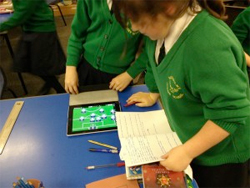
As my role this year involves me teaching across the whole school using a class set of iPads, I feel it is important to really experiment to see how using the iPads can impact across the curriculum and not just within ICT. Consequently, with the Year 5 cohort, I put together a project linking literacy with football. I decided to do this project for two reasons: (1) to see whether using the topic of football can engage the more reluctant boy writers in the class, and (2) to see how well linking digital media and speaking and listening can impact on the children's writing.
As I was working with the classes once a week, the lessons ran over a half term. However, it was the lesson the children looked forward to each week as they were completely enthralled and engaged due to the activities involving speaking and listening whilst using the iPads. I have found that the children's confidence and willingness to write after having the quality time to discuss ideas and experiment leading up to a finished piece of writing had a massive impact on the final product.
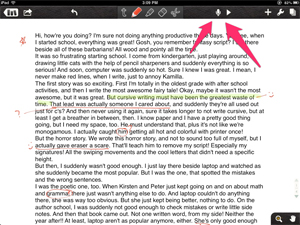
When it comes to learning, feedback is critical. So when it comes to one's writing, the principle is no different.
I have been teaching English for only six years but have struggled with this feedback process time and time again. I realise it is the most important part, and yet to do it effectively, I must commit literally hours to making sure I do it right. It's the proverbial thorn in my side.
Then when we went 1:1 with iPads in December of 2011, we discovered Notabilty. I played around with it and at first was impressed. I thought it to be a very versatile note-taking app. Then I discovered that it also has the ability to record audio along with the notes. And that's when the lightbulb exploded.
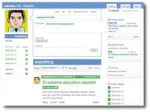
If OFSTED were to walk into a lesson tomorrow they would see the following:

This post was inspired by the #ipadagogy hashtag I came across recently on Twitter. This basically involves learning about the iPad. But I would like to suggest an alternative to this: ipedagogy. It seems rather a small change of just one letter, but it does change the focus rather fundamentally. I would like to suggest that we should try to foster the kind of environment in our classes, where students would learn everything in the same way as you learnt how to use an iPad.
We need to hide the ‘manual’. Learning becomes so much more meaningful to young people when they feel they have discovered facts and solutions for themselves. Serving it all up for them takes much of the magic out of learning, just as you lose out by not figuring out how to use an iPad on your own. One of the ways of doing this might be if we replaced textbooks by teacher-moderated, student-created, constantly evolving wikis. Surely this is not such a far fetched idea? We could even issue them with the textbook or study guide… But only after they’ve discovered most of it for themselves.
Photo credit: Yutaka Tsutano
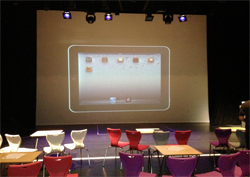
On Friday 28th of September we finally launched our iPad trial to all staff. There were only about three weeks to organise the event, but the whole thing went very well. Staff left excited, inspired and full of ideas. It really was an outstanding day!
After the summer holidays, I came back to school with the exciting prospect of our iPad trial. However, I realised how much work there was to do. Planning the launch to HoDs, as well as organising a whole school INSET, was pretty stressful. Luckily, the Assistant Head (teaching and learning) was amazing and really helped organise everything.
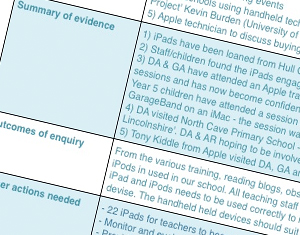
The 'iPad Journey' continues at Spring Cottage Primary School with the introduction of 16 iPads in Key Stage 1, 16 iPads in Key Stage 2, both with a syncing/charging trolley, and 63 iPod touches for children in Year 6.
With the iPod touches, iPads for both Key Stages set up, and Apple TV installed in each classroom, it was time for another staff training session, this time focusing on meeting the needs of a 21st century classroom. I began the staff training session by looking at the skills needed to be 21st century learners and the skills they would need to be successful in the future.

It is very easy to find a list of recommended apps for general or subject specific use. However, one of the iPads greatest strengths is its ability to help personalise learning for all. The following ideas are only a snapshot of the potential of the iPad when addressing the needs of each student (soldier).
‘Quiet, obedient and consistent, the Soldier charges into every assignment and stops only once enough damage is done to get the desired grade. Soldiers don’t show off. Soldiers don’t ask questions. Soldiers don’t complain. Soldiers just get the job done.’
Trademark question: “What will we be graded on?”
iPad Tip: Create an audio-note using Soundcloud so they can review instructions. The educator can make suggestions for extension tasks. It also acts as an excellent prompt if the educator can see the soldier doesn’t want to collaborate.
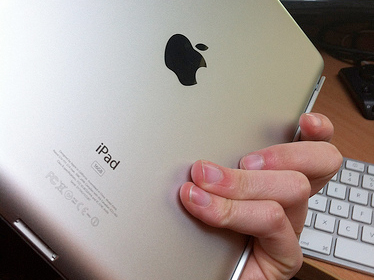
If the iPad is making a ‘move’ on your classroom this year then these ten points are worth considering:
|
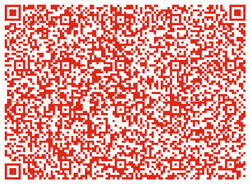
It has been recognised for some time now that using QR codes can really support learning but how can the iPad support the use of QR codes in the classroom?
Well the fact that it has the camera built in makes it super-handy for working in the classroom with QR codes, but how can they be used to support learning, what methods can you employ in order to create them and then share them?
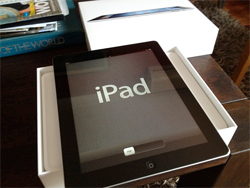
Parents have a very different perspective. Whilst educators wax lyrical about the potential of the iPad for learning, there are concerns from parents about its impact on their child. Or so we thought.
All parents of iPad trial students were asked to complete a questionnaire, attend a focus group meeting and email any further thoughts to inform the decision making progress for future iPad use. A great deal of time was taken by these parents as they were keen to convey their thoughts to inform the research process and we are very grateful for all their efforts.
Below are direct responses to questions from the focus group where parents were encouraged to discuss with each other the various advantages and disadvantages of the iPad for learning.
Photo credit: http://www.flickr.com/photos/dgmckelvey

A community-driven platform for showcasing the latest innovations and voices in schools
Pioneer House
North Road
Ellesmere Port
CH65 1AD
United Kingdom